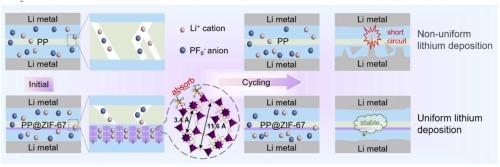通过阴离子亲ZIF-67改性隔膜稳定无枝晶锂金属电池
IF 6.3
2区 材料科学
Q2 CHEMISTRY, PHYSICAL
引用次数: 0
摘要
锂金属电池因其较高的理论容量而受到越来越多的关注,但锂枝晶问题及其相关的安全性问题严重阻碍了锂金属电池的实际应用。本文采用精心设计的ZIF-67阴离子型金属有机骨架(MOF)作为Li+溶剂解离剂,成功制备了一种调节离子传输的多功能分离器,用于稳定锂金属电极。将ZIF-67和聚偏氟乙烯(PVDF)的均匀混合物涂覆在聚丙烯(PP)分离器上,制备了连续均匀的MOF分离器。值得注意的是,MOF内发育良好的不饱和金属位点可以作为Li+溶剂化物的阴离子调节剂,有利于限制阴离子的自由迁移行为。此外,mof中由大钠盐笼(11.6 Å)和小孔窗(3.4 Å)形成的固有离子纳米通道有助于实现Li+ (0.76 Å)的快速转移。发现MOF分离器能有效抑制锂枝晶和寄生反应。使用PP@ZIF-67分离器的锂|锂对称电池在超过700 h的时间内实现均匀的锂沉积,并且即使在60°C下也具有稳定的可循环性。此外,与该多功能分离器组装的LiMn0.7Fe0.3PO4|Li (PP@ZIF-67)显示出提高的速率能力和循环稳定性。构建MOF改性隔膜是提高电池性能的一种很有前景的方法,有助于深入研究MOF在锂电池中的整体应用。本文章由计算机程序翻译,如有差异,请以英文原文为准。

Stabilizing dendrite-free lithium metal batteries via an anionphilic ZIF-67 modified separator
Lithium metal batteries (LMBs) have garnered increasing attentions owing to their high theoretical capacity, but the issue of lithium dendrites and associated safety concerns have seriously hampered the real-world applications. Herein, using a well-designed ZIF-67 anionphilic metal-organic framework (MOF) as a Li+ solvent dissociator, a multifunctional separator regulating ion transport is successfully fabricated for stabilizing lithium metal electrodes. The continuous and homogeneous MOF separators are prepared by coating the uniform mixtures of ZIF-67 and the poly(vinylidene difluoride) (PVDF) on polypropylene (PP) separators. Notably, the well-developed unsaturated metal sites within the MOF can serve as anionphilic regulators for Li+-solvates, favorable for limiting the free migration behavior of anions. Besides, the inherent ionic nanochannels formed by large sodalite cages (11.6 Å) and small pore windows (3.4 Å) in the MOFs assist in enabling rapid transfer of Li+ (0.76 Å). It is found that the MOF separator effectively inhibits lithium dendrites and parasitic reactions. The Li|Li symmetric cell with the PP@ZIF-67 separator achieves uniform lithium deposition more than 700 h and steady cyclability even at 60 °C. In addition, the LiMn0.7Fe0.3PO4|Li assembled with this multifunctional separator (PP@ZIF-67) demonstrates promoted rate capability and cycling stability. Constructing MOF-modified separators has emerged as a promising approach to enhance battery performance, facilitating in-depth research on the overall application of MOF in lithium batteries.
求助全文
通过发布文献求助,成功后即可免费获取论文全文。
去求助
来源期刊

Journal of Alloys and Compounds
工程技术-材料科学:综合
CiteScore
11.10
自引率
14.50%
发文量
5146
审稿时长
67 days
期刊介绍:
The Journal of Alloys and Compounds is intended to serve as an international medium for the publication of work on solid materials comprising compounds as well as alloys. Its great strength lies in the diversity of discipline which it encompasses, drawing together results from materials science, solid-state chemistry and physics.
 求助内容:
求助内容: 应助结果提醒方式:
应助结果提醒方式:


